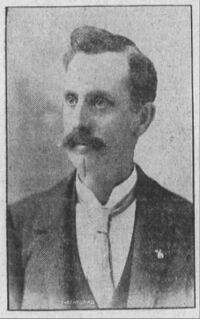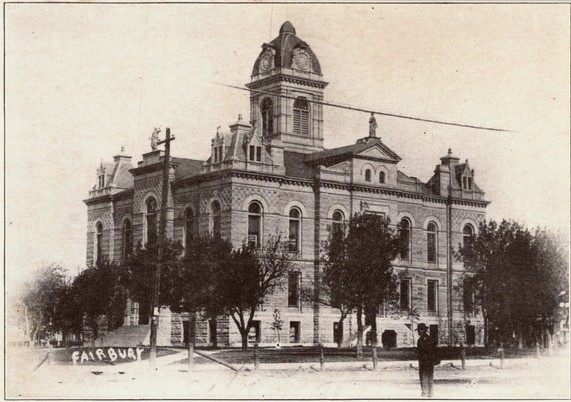James Clinton Holland (1853-1919), Architect
Practiced primarily as J. C. Holland and J. C. Holland & Co.
James Clinton Holland was born in Lima, Ohio, to Lydia and B. H. Holland. His father was a "House Joiner" to whom James was apprenticed in 1870.[1][2] James attended Northwestern Ohio Normal University (NONU) for two years and Cornell University for two years, studying architecture. He worked as a carpenter, contractor, and architect in Ohio, then taught architecture at NONU in 1883-1884 before moving to Topeka, Kansas in 1885. There he had a productive architectural career for over 30 years, designing courthouses across Kansas as well as some projects in neighboring Nebraska. He married Lizzie Baker in 1882 and they had two sons and a daughter. Holland died in 1919 in Topeka.[3][4]
This page is a contribution to the publication, Place Makers of Nebraska: The Architects. See the format and contents page for more information on the compilation and page organization.
Contents
Compiled Nebraska Directory Listings
none
Educational & Professional Associations
1870: "apprenticed carpenter" (presumably to his father, "House Joiner" B. H. Holland), Liberty, Ohio.[2]
1876-77: employed by architects Rumbaugh & Bacon, Toledo, Ohio.[5]
c. 1878-1880: carpenter, Ada, Ohio.[6]
c. 1880-82: student, Northwestern Ohio Normal University (now Ohio Northern University), Ada, Ohio.[5][6]
1882-83: studied architecture, Cornell University, Ithaca, New York.[5]
1883-85: architecture instructor, Northwestern Ohio Normal University, Ada, Ohio.[4][5][7]
1885-89: partner with C. B. Hopkins in Hopkins & Holland, architects, Topeka, Kansas.[8-10]
c. 1887: employed James J. Scott, Topeka, Kansas.[28]
1890-1903: architect, Topeka, Kansas.[4]
1895-97: Kansas state architect & state house architect, Topeka, Kansas.[4]
1897-98: special architect for Santa Fe Railway, Topeka, Kansas.[4]
1898-c. 1908: principal and partner with Frank C. Squires, Holland & Squires, architects, Topeka, Kansas.[4][23]
c. 1909-19: principal & partner with son Barton A. as J. C. Holland & Son, architects, Topeka, Kansas.[4]
Nebraska Buildings & Projects
Jefferson County Courthouse (1890-92), Fairbury, Nebraska.[11-13][a][b] (JF04-050) NRHP
City Hall & hose house (1891), Fairbury, Nebraska.[19]
Proposal to "transform the national bank building into a hotel...and...opera house..." (1892), Fairbury, Nebraska.[14]
Plans for addition to George W. Holland residence (1892), Falls City, Nebraska.[15]
Fairbury Baptist church (1892), Fairbury, Nebraska.[16][18]
Conrad Block (1892-93), 401-403 D Street, Fairbury, Nebraska.[16][20][c]
Methodist Episcopal Church (1892-93), Falls City, Nebraska.[17]
Consulted with Thayer County officials "on the court house question" (1894), Hebron, Nebraska.[22]
Holland was among four architects who sought "a hearing" before Hamilton County board "before closing a contract with William Gray..." (1894), Aurora, Nebraska.[23][d]
Holland was among a large group of architects from several states who presented designs for the Wayne County Courthouse (1899), Wayne, Nebraska.[58][e]
Notes
a. Over a dozen architects submitted plans for the Jefferson County Courthouse in Fairbury, including firms from Kansas, Missouri, Illinois, and Missouri. Nebraska architects included F. M. Ellis and J. McDonnell from Omaha; J. G. Cordner, O. P. Lacey (should be Otis Placey), Parsons & Son, and W. S. Gray from Lincoln; Marcus Leach from Wymore; George McDonald from Fremont; and C. C. Rittenhouse from Hastings. J. C. Holland as the sole applicant from Kansas.[11]
b. A Nebraska newspaper mentioned in 1891 that the newly laid cornerstone was inscribed "J. C. Holland, architect."[13]
c. Conrad Block in Fairbury was within Fairbury Commercial Historic District, National Register of Historic Places. Now (2024) demolished.[21]
d. Holland, along with Omaha architects "F. M. Ellis and W. E. Findley, and C. C. Rittenhouse of Hastings, all architects of high standing..." visited Aurora in 1894, seeking a hearing "to show their work" if the County Board "...decided to grant them a hearing...before closing a contract" with Lincoln architect William Gray to design the Hamilton County Courthouse. According to an Aurora newspaper, the visiting architects received their hearing on March 8th, then Gray's selection was confirmed on May 15, 1894.[24][25]
e. At least ten architects "were here [in Wayne] exhibiting different plans" to the Wayne County board, including representatives from Iowa, Missouri, Wisconsin, New York, Illinois, and Minnesota. In addition to Holland, Nebraska architects vying for the commission were G. A. Berlinghof, J. S. Cordner, and J. T. Guth. Orff & Guilbert of Minneapolis were ultimately chosen.[26][27]
References
1. Ancestry.com. U.S., Find a Grave® Index, 1600s-Current,]] s.v. "James Clinton Holland, [database on-line]. Lehi, UT, USA: Ancestry.com Operations, Inc., 2012.
2. Ancestry.com. 1870 United States Federal Census, s.v. "J. C. Holland" in Liberty, Ohio, [database on-line]. Lehi, UT, USA: Ancestry.com Operations, Inc., 2009.
3. "James C. Holland," in Wikipedia, the Free Encyclopedia, database on-line accessed May 23, 2025 at https://en.wikipedia.org/wiki/James_C._Holland
4. "J. C. Holland Dies--Veteran Topeka Architect Came Here in 1885. He Planned State House and Many Big Buildings," Topeka (Kansas) State Journal (May 28, 1919), 1.
5. "James C. Holland," Topeka (Kansas) Daily Press (October 26, 1895), 11.
6. Ancestry.com and The Church of Jesus Christ of Latter-day Saints. 1880 United States Federal Census. s.v. "James Holland," [database on-line]. Lehi, UT, USA: Ancestry.com Operations Inc, 2010.
7. "Instructors for the School Year of 1883-84...J. C. Holland: Architecture," Annual Catalogue of the Teachers and Students of the North-Western Ohio Normal School...for the School Year 1882-83...Ada, Hardin Co[unty], O[hio], Ada, Ohio: Record Steam Job Printing Rooms, 1883, 5.
8. "A Good Firm of Architects," Daily Commonwealth (Topeka, Kansas) (June 3, 1885), 8.
9. "Ready to Help on the 'Boom'," Topeka (Kansas) Daily Capital (January 21, 1886), 12.
10. "Notice of Dissolution....The firm of Hopkins & Holland, architects..." Topeka (Kansas) Daily Capital (August 28, 1889), 3.
11. "Fairbury's Court House Plans," Omaha (Nebraska) World-Herald (July 11, 1890), 6.
12. Correspondence, Nebraska State Historical Society Archives, RG238.
13. "Corner Stone Laying" (Jefferson County Courthouse), Diller (Nebraska) Record (July 10, 1891), 2.
14. "D. B. Cropsey showed the reporter...plans and specifications...by J. C. Holland...," Jefferson County Journal (Fairbury, Nebraska) (May 21, 1892), 5.
15. "J. C. Holland...drawing plans for quite an addition that [his uncle] George [W. Holland] intends building to his residence this summer," Falls City (Nebraska) Daily News (June 3, 1892), 3.
16. "J. C. Holland, the architect fo the court house, Baptist church and the Conrad building, was in town...yesterday," Fairbury (Nebraska) Gazette (October 15, 1892), 5.
17. "J. C. Holland, of Topeka, the architect of the new Methodist church, was in the city...," Falls City (Nebraska) Daily News (November 18, 1892), 3.
18. "A church meeting was held at the Baptist church...," Jefferson County Journal (Fairbury, Nebraska) (June 4, 1892), 5.
19. "Proposals. Notice to Contractors," Fairbury (Nebraska) Gazette (May 16, 1891), 4.
20. "David. Groff serves to-day his first dinner in his elegant new quarters in the new Conrad building...," Jefferson County Journal (Fairbury, Nebraska) (August 12, 1893), 5.
21. Mississippi Valley Archaeology Center, "Fairbury Commercial Historic District, Fairbury, Jefferson County, Nebraska," 1997 nomination to the NRHP, accessed on-line May 24, 2025 at https://npgallery.nps.gov/GetAsset/e231dab0-4668-4531-9629-b991060c2fdf
22. "J. C. Holland, of Topeka, Kan., was in Hebron, Wednesday..." Hebron (Nebraska) Journal (March 9, 1894), 3.
23. Richard J. Cathon (KS State Historical Society), "St. John's Lutheran School," a nomination to the National Register of Historic Places, 1984, accessed on-line May 26, 2025, at https://npgallery.nps.gov/NRHP/GetAsset/NRHP/85000014_text
24. "J. C. Holland, of Topeka, Kansas...[with 3 other]...architects of high standing were in the city...," Republican-Register (Aurora, Nebraska) (March 16, 1894), 5.
25. Digest of County Board actions March 6-15, 1894, Hamilton County Register (Aurora, Nebraska) (March 17, 1984), 5.
26. "The county commissioners met on Tuesday...viewing the different designs and plans presented by some ten or a dozen architects for the proposed new court house...," Wayne (Nebraska) Herald (February 9, 1899), 1.
27. Daniel Kidd (Nebraska State Historical Society), "Wayne County Courthouse," nomination to the National Register of Historic Places, 1979, accessed on-line May 26, 2025, at http://www.e-nebraskahistory.org/index.php?title=NRHP:_Wayne_County_Courthouse
28. "Personal...James J. Scott, who was formerly with Hopkins & Holland..." Topeka (Kansas) Daily Press (December 24, 1887), 4.
Page Citation
E. F. Zimmer & D. Murphy, “James Clinton Holland (1853-1919), Architect,” in David Murphy, Edward F. Zimmer, and Lynn Meyer, comps. Place Makers of Nebraska: The Architects. Lincoln: Nebraska State Historical Society, January 26, 2015; updated May 24, 2025 http://www.e-nebraskahistory.org/index.php?title=Place_Makers_of_Nebraska:_The_Architects Accessed, December 15, 2025.
Contact the Nebraska State Historic Preservation Office with questions or comments concerning this page, including any problems you may have with broken links (see, however, the Disclaimers link at the bottom of this page). Please provide the URL to this page with your inquiry.

